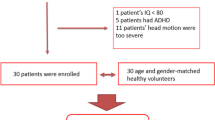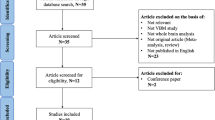Abstract
Although midbrain nuclei (substantia nigra, ventral tegmental area, and periaqueductal grey) are considered candidate loci of pathology in Tourette’s syndrome (TS), few imaging studies have examined midbrain structure. The objective of this study was to evaluate the presence of subtle structural abnormalities in the midbrain of patients with TS. High-field magnetic resonance imaging (MRI) (1.5- and 3-T) was used in 23 patients with TS and in 20 age- and sex-matched normal control subjects. Tics symptoms were rated using the Yale Global Tic Severity Scale and comorbid neuropsychiatric disorders were evaluated with standardised psychiatric rating scales. MRI scans revealed subtle structural abnormalities consistent with expanded perivascular spaces (EPVS) in the substantia nigra (compacta and reticulata) and neighbouring nuclei in 6 (26%) patients with TS, but in none of the normal control subjects (P = 0.045). Stereotyped movements were more frequent (P = 0.017) amongst TS patients with midbrain EPVS than in TS patients with normal MRI. Parkinsonism, posttraumatic stress disorder and autistic spectrum disorders exclusively occurred in TS patients with midbrain EPVS. There were no significant between-group differences in other comorbid neuropsychiatric disorders and in tics. Although EPVS are generally viewed as incidental findings, our results suggest that when EPVS are located in the midbrain they may be symptomatic. These abnormalities would reduce the actual number of neurons in specific midbrain nuclei (e.g., substantia nigra) and disrupt their connectivity with limbic, associative, and motor circuits.


Similar content being viewed by others
References
Albin RL, Mink JW (2006) Recent advances in Tourette syndrome research. Trends Neurosci 29:175–182
Amat JA, Bronen RA, Saluja S, Sato N, Zhu H, Gorman DA, Royal J, Peterson BS (2006) Increased number of subcortical hyperintensities on MRI in children and adolescents with Tourette’s syndrome, obsessive–compulsive disorder, and attention deficit hyperactivity disorder. Am J Psychiatry 163:1106–1108
American Psychiatric Association (1994) Diagnostic and statistical manual of mental diseases, 4th edn. (DSM-IV). American Psychiatric Association, Washington, DC
Baym CL, Corbett BA, Wright SB, Bunge SA (2008) Neural correlates of tic severity and cognitive control in children with Tourette syndrome. Brain 131:165–179
Bech P, Kastrup M, Rafaelsen OJ (1986) Mini-compendium of rating scales for states of anxiety, depression, mania, and schizophrenia, with corresponding DSM III syndromes. Acta Psychiatr Scand Suppl 326:1–37
Berthier ML, Kulisevsky J, Asenjo B, Aparicio J, Lara D (2003) Comorbid Asperger and Tourette syndromes with localized mesencephalic, infrathalamic, thalamic and striatal damage. Dev Med Child Neurol 45:207–212
Cavanna AE, Servo S, Monaco F, Robertson MM (2009) The behavioral spectrum of Gilles de la Tourette syndrome. J Neuropsychiatry Clin Neurosci 21:13–23
Cerna F, Mehhad B, Luby JP, Burns D, Fleckenstein JL (1999) St. Louis encephalitis and the substantia nigra: MR imaging evaluation. Am J Neuroradiol 20:1281–1283
Dale RC, Church AJ, Heyman I (2003) Striatal encephalitis after varicella zoster infection complicated by tourettism. Mov Disord 18:1554–1556
Dale RC, Church AJ, Surtees RAH, Lees AJ, Adcock JE, Harding B, Neville BG, Giovannoni G (2004) Encephalitis lethargica syndrome: 20 new cases and evidence of basal ganglia autoimmunity. Brain 127:21–33
DeLong MR, Wichmann T (2007) Circuits and circuit disorders of the basal ganglia. Arch Neurol 64:20–24
Devinsky O (1983) Neuroanatomy of Gilles de la Tourette’s syndrome. Possible midbrain involvement. Arch Neurol 40:508–514
Elster AD, Richardson DN (1991) Focal high signal on MR scans of the midbrain caused by enlarged perivascular spaces: MR-pathologic correlation. AJR Am J Roentgenol 156(1):157–160
Friedman JH (2007) Stereotype and catatonia. In: Jankovic J, Tolosa E (eds) Parkinson disease and movement disorders, 5th edn. Lippincott Williams and Wilkins, Philadelphia, pp 468–480
Fudge JL, Emiliano AB (2003) The extended amygdala and the dopamine system: another piece of the dopamine puzzle. J Neuropsychiat Clin Neurosci 15:306–316
Garraux G, Goldfine A, Bohlhalter S, Lerner A, Hanakawa T, Hallett M (2006) Increased midbrain gray matter in Tourette’s syndrome. Ann Neurol 59:381–385
Gilbert DL, Christian BT, Gelfand MJ, Shi B, Mantil J, Sallee FR (2006) Altered mesolimbocortical and thalamic dopamine in Tourette syndrome. Neurology 67:1695–1697
Gironell A, Rodríguez-Fornell A, Kulisevsky J, Pascual B, Riba J, Barbanoj M, Berthier M (2000) Abnormalities of the acoustic startle reflex and reaction time in Gilles de la Tourette syndrome. Clin Neurophysiology 111:1366–1371
Goodman WK, Price LH, Rasmussen SA, Mazure C, Fleischmann RL, Hill CL, Heninger GR, Charney DS (1989) The Yale-Brown Obsessive Compulsive Scale: development, use and reliability. Arch Gen Psychiatry 46:1006–1011
Graybiel AM (2008) Habits, rituals and the evaluative brain. Ann Rev Neuroscience 31:359–387
Hallevi H, Oh IJ, Valdez SR, Kidder BG, Schiess MC (2008) Postencephalitic Parkinsonism: clinical imaging correlation. Arch Neurol 65:837
Houeto JL, Karachi C, Mallet L, Pillon B, Yelnik J, Mesnage V, Welter ML, Navarro S, Pelissolo A, Damier P, Pidoux B, Dormont D, Cornu P, Agid Y (2005) Tourette’s syndrome and deep brain stimulation. J Neurol Neurosurg Psychiatry 76:992–995
Kalita J, Misra UK (2000) The substantia nigra is also involved in Japanese encephalitis. Am J Neuroradiol 21:1978–1979
Kulisevsky J, Litvan I, Berthier ML, Pascual-Sedano B, Paulsen JS, Cummings JL (2001) Neuropsychiatric assessment of Gilles de la Tourette patients: comparative study with other hyperkinetic and hypokinetic movement disorders. Mov Disord 16:1098–1104
Kumar R, Lang AE (1997) Coexistence of tics and parkinsonism: evidence for non-dopaminergic mechanism in tic pathogenesis. Neurology 49:1699–1701
Lakke JP, Wilmink JT (1985) A case of Gilles de la Tourette’s syndrome with midbrain involvement. J Neurol Neurosurg Psychiatry 48:1293–1296
Leckman JF, Cohen DJ (1999) Tourette’s Syndrome—tics, obsessions, compulsions. Developmental psychopathology and clinical care. Wiley, New York
Leckman JF, Riddle MA, Hardin MT, Ort SI, Swartz KL, Stevenson J, Cohen DJ (1989) The Yale Global Tic Severity Scale: initial testing of a clinician-rated scale of tic severity. J Amer Acad Child Adolesc Psychiatry 28:566–573
Meyer-Luehmann M, Thompson JF, Berridge KC, Aldridge JW (2002) Substantia nigra pars reticulata neurons code initiation of a serial pattern: implications for natural action sequences and sequential disorders. Eur J Neurosci 16(8):1599–1608
Miller EN (1986–2001) California Computerized Assessment Package™ manual. 2nd edn. Los Angeles, CA
Muthugovindan D, Singer H (2009) Motor stereotype disorders. Curr Opin Neurol 22:131–136
Paxinos G, Huang X-F (1995) Atlas of the human brainstem. Academic Press Inc, San Diego
Peterson BS, Bronen RA, Duncan CC (1996) Three cases of symptom change in Tourette’s syndrome and obsessive-compulsive disorder associated with paediatric cerebral malignancies. J Neurol Neurosurg Psychiatry 61:497–505
Robertson MM (2000) Tourette syndrome, associated conditions and the complexities of treatment. Brain 123(Pt 3):425–462 (review)
Robertson MM (2006) Behavioral and affective disorders in Tourette syndrome. Adv Neurol 99:39–60
Romi F, Tysnes O-B, Krákenes J, Savoiardo M, Aarli JA, Bindoff L (2002) Cystic dilation of Virchow–Robin spaces in the midbrain. Eur Neurol 47:186–188
Saeki N, Sato M, Kubota M, Uchino Y, Murai H, Nagai Y, Ishikura H, Nomura S, Matsuura I, Yamaura A (2005) MR imaging of normal perivascular space expansion at midbrain. Am J Neuroradiol 26:566–571
Sánchez-González MA, García-Cabezas MA, Rico B, Cavada C (2005) The primate thalamus is a key target for brain dopamine. J Neuroscience 25:6076–6083
Sandyk R (1988) A case of Tourette’s syndrome with midbrain involvement. Int J Neurosci 43:171–175
Shale H, Fahn S, Mayeux R (1986) Tics in a patient with Parkinson’s disease. Mov Disord 1:79–83
Sheehan DV, Janavs J, Baker R, Harnett-Sheehan K, Knapp E, Sheehan M (1998) MINI international neuropsychiatric interview. English version 5.0.0, DSM-IV. J Clin Psychiatry 59(suppl 20):34–57
Shtasel DL, Gur RE, Mozley D, Richards J, Taleff MM, Heimberg C, Gallacher F, Gur RC (1991) Volunteers for biomedical research: recruitment and screening of normal controls. Arch Gen Psychiatry 48:1022–1025
Smith SMJ, Lees AJ (1989) Abnormalities of the blink reflex in Gilles de la Tourette syndrome. J Neurol Neurosurg Psychiatry 52:895–898
Acknowledgments
The authors thank Francisco Alfaro and Diego Lara for technical advice on MRI studies.
Conflict of interest statement
The authors declare that they have no conflict of interest.
Author information
Authors and Affiliations
Corresponding author
Rights and permissions
About this article
Cite this article
Dávila, G., Berthier, M.L., Kulisevsky, J. et al. Structural abnormalities in the substantia nigra and neighbouring nuclei in Tourette’s syndrome. J Neural Transm 117, 481–488 (2010). https://doi.org/10.1007/s00702-010-0369-8
Received:
Accepted:
Published:
Issue Date:
DOI: https://doi.org/10.1007/s00702-010-0369-8




